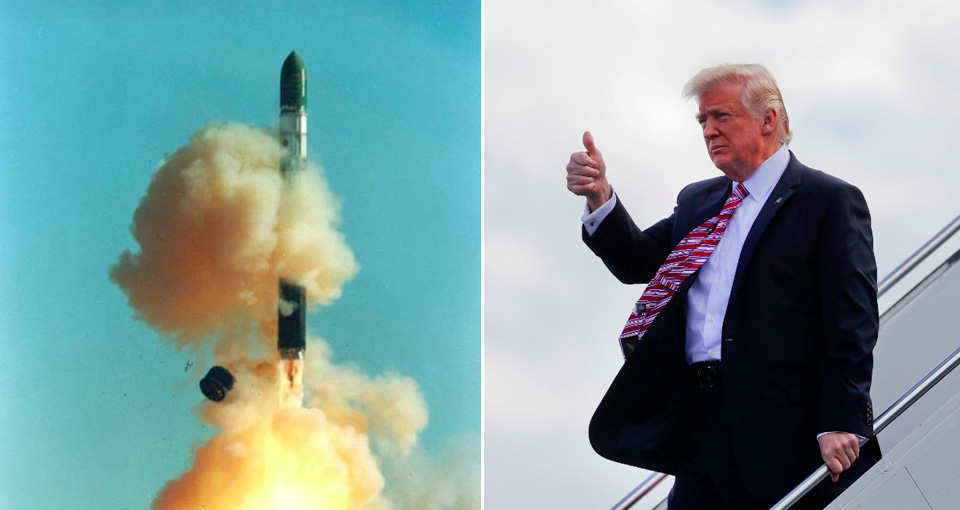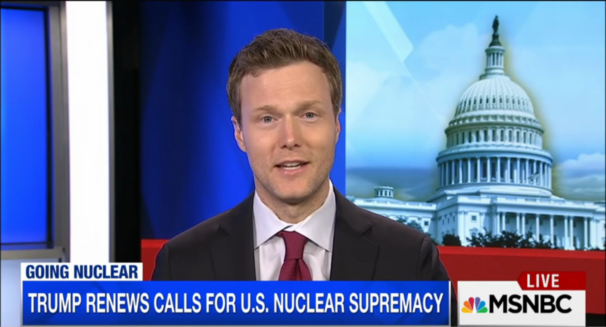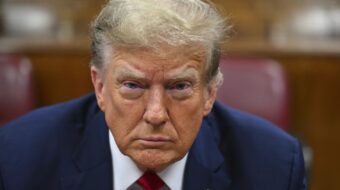
When President Trump declared on MSNBC’s Morning Joe “Let it be an arms race,” I truly felt as though maybe I needed to double check my high school history book. To my recollection, the arms race portion of the chapter on the Cold War between the Soviet Union and the United States was, by all accounts, a terrifying time for both belligerents.
When I would come home from school and tell my parents about the tornado drill that my classmates and I engaged in earlier in the day, I would undoubtedly hear something about how “when we were your age, we had nuclear bomb drills.”
When they described what was essentially the same drill, I laughed at how similar the two were given the key distinction between them. Sure, tornados and nuclear weapons both cause destruction by tearing apart buildings and tossing humans like rag dolls, except with nuclear weapons everything is also instantly on fire. Ducking and covering probably won’t help that.
As someone who was an infant when the Berlin Wall came down, the new Cold War that both Democrats and Republicans have bought into in their own ways seems like a deliberate step backward. Wasn’t the restoration of capitalism in the Soviet Union supposed to make the world a more peaceful place?

How naïve we were.
The U.S. and Russia still hold the majority of the world’s nuclear weapons, and the continued escalation of tensions between them is nothing short of suicidal. The nuclear disarmament and peace movements are in desperate need of a comeback because Cold War ways of thinking are creeping back into public discourse.
“Mr. President, we cannot allow a mineshaft gap!”
Enter Georgetown Professor Matthew Kroenig. He’s a curious combination of David Beckham and Dr. Strangelove’s Gen. Buck Turgidson. While he misses the technical cutoff point for a millennial by a few years, he’s a fresh face for nuclear expansion and brinksmanship.
To be fair, Kroenig would deny being an overt proponent of nuclear war. Why, he’s a levelheaded expert. He appeared on MSNBC twice this past weekend to talk about America’s need to build up and modernize its nuclear stockpile as an effective deterrent.
When asked by host Alex Witt what he would say to someone like me who fears an arms race, Kroenig explained that Donald Trump’s position is not significantly more extreme than Hillary Clinton’s during the campaign, or than those of presidents past.
“These comments got attention, but they’re pretty consistent with what U.S. leaders have said over the years,” said Kroenig, as if there was any comfort to be found in the consistency of nuclear suicidal ideation.
Kroenig goes on to say that the United States already has a robust nuclear arsenal, but that Russia’s is more robust with over 1,700 nuclear warheads compared to our 1,300.
“Russia has been relying more, not less on nuclear weapons,” Kroenig asserted. What Kroenig would like you to forget is that, since 2011, the United States along with NATO has been building up missile capacity in Europe and that, more recently, NATO has built up its troop presence in Germany to defend against a “possible Russian invasion” that was never threatened.
Russia has called the U.S. Missile Defense System a “direct threat,” to which Obama administration deputy secretary of defense Robert Work responded last May, in possibly the most dangerous game of “I’m not touching you” in world history, that the shield is not actually targeting Russia.
How can Russia believe that? Furthermore, how can the U.S. overlook Russian placements of cruise missiles near any one of the thirty countries it is obligated to protect? This is the terrible gambit the world finds itself in when nuclear weapons continue to exist, but not to worry! Matthew Kroenig has just the factoids to help us sleep at night.
“Mr. President, I’m not saying we wouldn’t get our hair mussed. But I do say no more than ten to twenty million killed, tops. Uh, depending on the breaks.”
“On the point of destroying the world many times over, many people believe that but it’s just not true. One of the things the U.S. does differently than other countries is we comply with the laws of war,” Kroenig said with a straight face.

Aside from the facts that we’re the only nation to ever use nuclear weapons (a war crime in spirit, if not in letter), we used white phosphorous in Iraq, and that we faced allegations of torture in Afghanistan, the U.S. has shown that the rules of war are meant to be bent, if not broken.
He continued, “We don’t use nuclear weapons on cities, we use them on other countries’ nuclear weapons.” My follow-up would have been to ask Kroenig to take into account the ecological effects of radiation on water or food, as well as the ghastly mutations and birth defects that will continue for generations after nuclear weapon use. I guess it depends on your definition of “destroying the world.”
When the interviewer clarified that maybe the “many times over” part could be an exaggeration and that “all we need to do is to destroy the world once over,” Kroenig smiled and clarified that, in his new book, he cites a report from the Johns Hopkins physics laboratory saying that it would take 140,000 nuclear weapons to kill every American citizen, but that “Russia has roughly 1,000.”
Back of an envelope, wholly unscientific calculations with those figures put the estimated death toll per nuclear bomb at 2,100 humans, however, the average power of the bombs used to calculate this rosy projection are unknown to me.
Also casting doubt on these numbers is the conservative estimate of 225,000 deaths from the only two nuclear bombs ever used in war, combined with Kroenig’s own assertion that the U.S. is unique in that it can be relied upon to follow the rules of war.
Even if Kroenig was not wrong, and Russia only set aside a maximum of 1,000 bombs for the U.S., that still means thousands of dead human beings. Policies that combine the expansion of nuclear weapon stockpiles combined with the new bi-partisan consensus against Russia have the potential to spiral out of control, especially with a president with known impulse control issues and a penchant for revenge.
“Nobody should downplay the devastation from a nuclear exchange,” said Kroenig after downplaying the devastation of a nuclear exchange, “they’re the most powerful weapons on earth, but nowhere near the ability to destroy the world many times over…”
buuut…
“If Russia is going to have more, then we need to have more to protect ourselves and our allies,” said Kroenig. Perhaps that’d make a fitting epitaph for a monument in our post-nuclear hellscape.












Comments